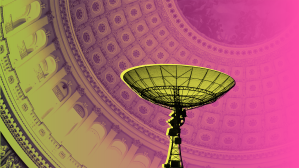GSA shares guidance for agencies seeking to purchase secure 5G

The General Services Administration on Thursday issued guidance to help federal agencies buy secure 5G wireless technology services.
The acquisition guidance, created by GSA’s Office of the IT Category, is meant to document optimal 5G deployment and best practices for agencies’ adoption of the technology across the federal government.
Federal leaders are bullish about adopting 5G wireless tech for its enhanced data transfer rates, increased latency, potential cost reductions, energy savings and more robust connectivity for large numbers of devices that can help to power emerging technologies that depend on those enhanced capabilities.
“5G networks have the potential to be faster, more reliable, and serve many more devices — and could provide infrastructure to help with everything from smart buildings to telemedicine,” Federal Acquisition Service Commissioner Sonny Hashmi said in a statement. “We’re pleased to be issuing this guidance to ensure that government can make the most of secure 5G in its efforts to deliver for the American people.”
GSA’s guidance comes after the passage of the Secure 5G and Beyond Act of 2020, which led to the National Strategy to Secure 5G that tasked the agency with “establishing acquisition processes to facilitate 5G infrastructure for classified information requirements.”
In the new guidance, GSA directs agencies and vendors to use “Best-in-Class” acquisition vehicles that offer secure 5G within their scope, like GSA’s own $50 billion Enterprise Infrastructure
Solutions (EIS) contract.
In addition to providing those acquisition strategies, the guidance also shares 5G use cases in government, 5G standards and other background information.
“Use cases are the real-world applications that agencies are pursuing, or want to achieve. Acquisition is the nuts and bolts of getting the solution in place in the most efficient and effective way. Once you understand the technology, know the standards, consider the security aspects, and are up-to-date on governmentwide policies, then it’s time to plan and execute. If you think of this strategy as a circle or wheel, the Use Case is the end of one cycle and the beginning of another. Each rotation strengthens our collective understanding of what makes a 5G deployment secure and successful,” Laura Stanton, GSA’s assistant commissioner for the Office of Information Technology Category, wrote in a blog post.
The guidance also stresses the importance of supply chain risk management as part of the federal adoption of 5G, ensuring that products and services agencies buy do not rely on technology built or influenced by foreign intelligence entities or other bad actors. It also reiterates that by law, federal agencies cannot contract with a number of Chinese companies like ZTE and Huawei — both of which provide 5G telecom services — nor can they work with other vendors who have products or services from those Chinese companies in their supply chain.
“In addition to protecting data on the network, a trusted, secure supply chain is also paramount. We cannot ensure the security of 5G networks if untrusted equipment or software is allowed to control any part of them,” Stanton wrote.




